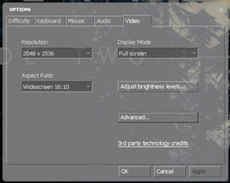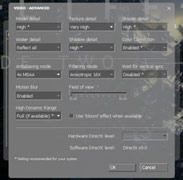Pre-OC Nvidia GeForce GTX 280 and 260
Written by Harry Butler
July 19, 2008 | 09:17
Tags: #260 #280 #amp #analysis #benchmarking #benchmarks #bfg #geforce #gtx #ocx #result #review #top

Half Life 2: Episode 2
Publisher: ValveAs one part of our game of the year 2007, Half-Life 2: Episode 2 set a new high in narrative and gameplay for the series. Using Valve's widely used, albeit not overly hardware intensive, Source engine that also features as a part of legendary games like Counter-Strike, Team Fortress 2 and Portal, we were keen to feature its performance here too.
The Source engine is the most scalable engine we test. While it still supports only DirectX 9.0, it features effects like dynamic lighting with HDR effects, motion blur, advanced Havok Physics and high model details.
Episode 2 took Half-Life outside into large open environments for the first time and we test with Gordon running through a large open level that combines forest and houses, with explosions and physics.
All in game detail settings are set to their highest levels, with HDR enabled, and for anti-aliasing MSAA was used where both settings were set from inside the game.
Due to performance issues encountered whilst benchmarking, we have repeated many of the tests for Half Life 2 for previously tested cards.
Half-Life 2: Ep Two
1600x1200, 16xAF, DX9, Maximum Detail
- ATI Radeon HD 4870
- BFG GeForce GTX 280 OCX
- Zotac GeForce GTX 260 AMP!
- Asus GeForce GTX 280 TOP
- Nvidia GeForce GTX 280
- Nvidia GeForce GTX 260
- Nvidia GeForce 9800 GTX+
- Nvidia Geforce 9800 GX2
- ATI Radeon HD 4850
- ATI Radeon HD 3870 X2
-
-
128.0
-
119.0
-
-
-
119.0
-
118.0
-
-
-
118.0
-
108.0
-
-
-
117.0
-
114.0
-
-
-
116.0
-
114.0
-
-
-
115.0
-
101.0
-
-
-
105.0
-
81.0
-
-
-
105.0
-
100.0
-
-
-
105.0
-
96.0
-
-
-
85.0
-
53.0
-
0
25
50
75
100
125
150
Frames Per Second
-
4xAA
-
8xAA
Half-Life 2: Ep Two
1920x1200, 16xAF, DX9, Maximum Detail
- BFG GeForce GTX 280 OCX
- Nvidia GeForce GTX 280
- ATI Radeon HD 4870
- Zotac GeForce GTX 260 AMP!
- Asus GeForce GTX 280 TOP
- Nvidia GeForce GTX 260
- Nvidia Geforce 9800 GX2
- ATI Radeon HD 4850
- Nvidia GeForce 9800 GTX+
- ATI Radeon HD 3870 X2
-
-
113.0
-
106.0
-
-
-
112.0
-
101.0
-
-
-
112.0
-
103.0
-
-
-
112.0
-
95.0
-
-
-
110.0
-
105.0
-
-
-
107.0
-
88.0
-
-
-
98.0
-
92.0
-
-
-
92.0
-
83.0
-
-
-
92.0
-
68.0
-
-
-
73.0
-
45.0
-
0
25
50
75
100
125
Frames Per Second
-
4xAA
-
8xAA
Half-Life 2: Ep Two
2560x1600, 16xAF, DX9, Maximum Detail
- Asus GeForce GTX 280 TOP
- BFG GeForce GTX 280 OCX
- Nvidia GeForce GTX 280
- Nvidia Geforce 9800 GX2
- Zotac GeForce GTX 260 AMP!
- Nvidia GeForce GTX 260
- ATI Radeon HD 4870
- Nvidia GeForce 9800 GTX+
- ATI Radeon HD 4850
- ATI Radeon HD 3870 X2
-
-
100.0
-
71.0
-
-
-
99.0
-
70.0
-
-
-
93.0
-
66.0
-
-
-
85.0
-
28.0
-
-
-
83.0
-
61.0
-
-
-
76.0
-
55.0
-
-
-
70.0
-
60.0
-
-
-
59.0
-
30.0
-
-
-
57.0
-
49.0
-
-
-
44.0
-
26.0
-
0
25
50
75
100
Frames Per Second
-
4xAA
-
8xAA
We've had some interesting issues in benchmarking Half Life 2: Episode 2 whilst benchmarking these cards, and the problem is obvious in the results tables. All the GeForce series cards seem to be hitting a performance "glass ceiling" of 120FPS at lower resolutions.
It's only when we test at the highest resolution that we see the advantages of the overclocked cards, which offer performance improvements of around seven frames a second over the stock cards. We're currently working with Nvidia to get to the root of this issue, and will post an addendum when we resolve it.











Want to comment? Please log in.